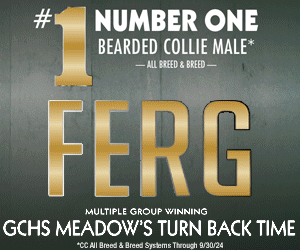Luck is the Religion of the Lazy
Click here to read the complete article
 By Dr. Carmen L. Battaglia
By Dr. Carmen L. Battaglia
Who would have imagined that dog shows would be affected by a fifteen-year slow, steady, consecutive decline in show entries? Now, after many attempts to stop this decline, exhibitors and handlers are wondering if they need some good luck to end the problem of entries of zero or only one dog in a breed. Many factors have been attributed to the entry problems and three stand out. The first is the slow and steady growth of Low Entry (LE) breeds which now have become 50% of the stud book. Another, is a steady increase in the number of clubs suffering from the greying effect. A third is the increased effort by the Animal Rights groups (AR) to influence breed clubs, breeders and the sport.
Much has been written about all three, and the sociological literature is full of material that shows how groups who use labels in their attacks on opponents, issues and organizations have been successful. Studies have demonstrated the effectiveness of undefined labels in defeating proposals and candidates running for political office. Labeling an issue, person or event with an offensive label has proven to be an effective way to defeat them and change the direction of issues. When applied to emotional issues like dog shows, dog bites and dog ownership, the impact of labels can be significant.
In the world of dogs, the primary user of the labeling process has been the Animal Rights groups (AR). They use undefined labels because they all lack a common definition and will easily generate an emotional response. Some of their favorite terms include: “Vicious Dog” and “Puppy Mill”. These terms are useful when attempting to impact the thinking of those who lack subject matter knowledge and others who are looking for answers.
The newest undefined label called the “Responsible Breeder” has more potential than its predecessors because it suggests that breeders will “do the right thing”. But underneath all this exterior labeling comes many assumptions that begin with the goal for quality pups from quality parents. For example, if a pup is born with less than ideal conformation or maybe a health problem, the “responsible breeder” is expected to make some hard choices about the disposition of that pup and the future use of its sire and dam. On the surface, no one disagrees with this approach because they see it as “raising the bar” by “doing the right thing”, which are two more undefined labels.
By not defining “Responsible Breeder”, “Raising the Bar”, and “Doing the Right Thing”, pressure can be applied to breeders through a series of questions and complaints that are used to influence them, their clubs and the public.
Click here to read the complete article

Short URL: https://caninechronicle.com/?p=192995
Comments are closed











